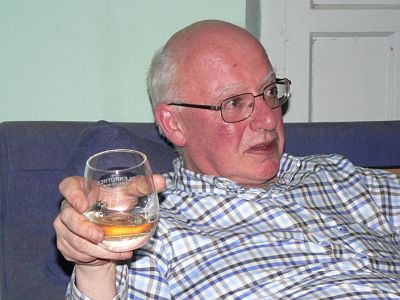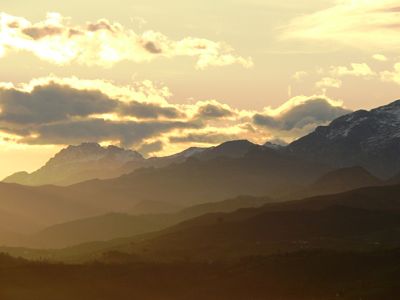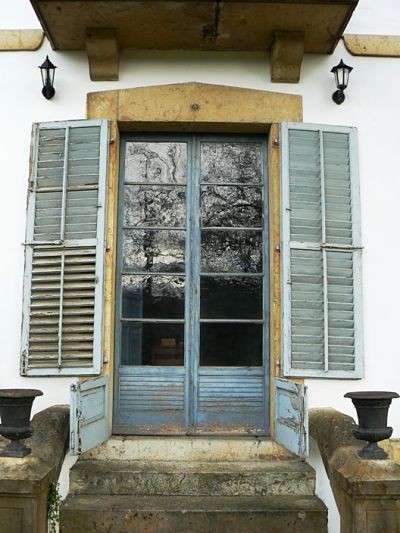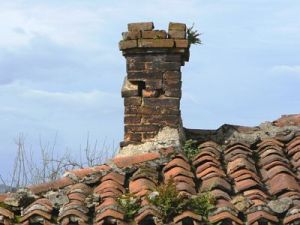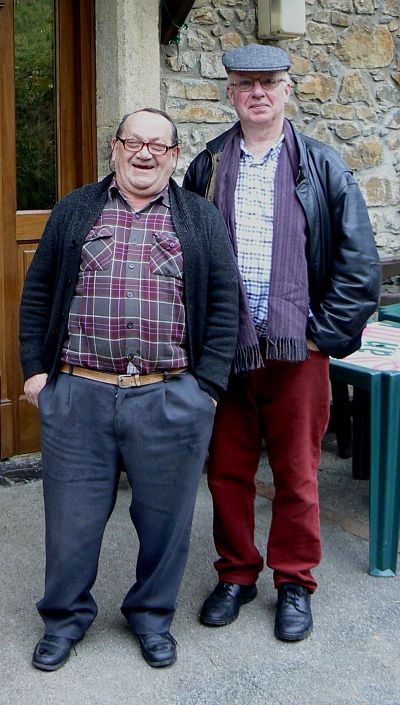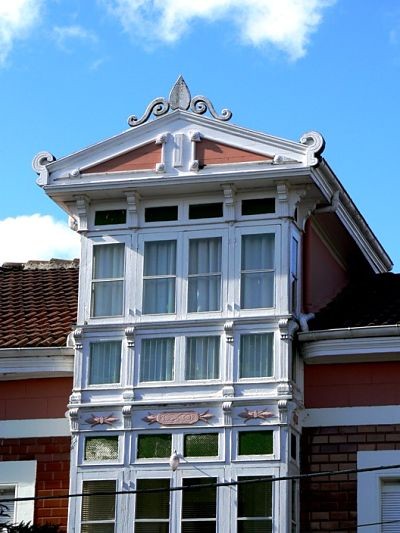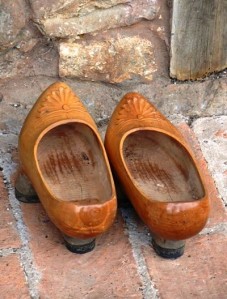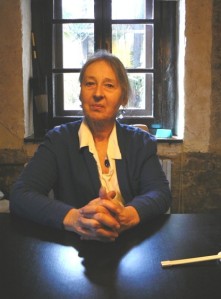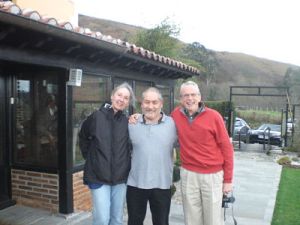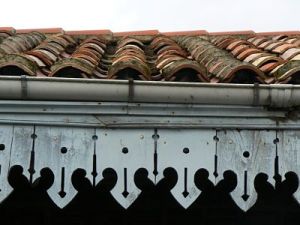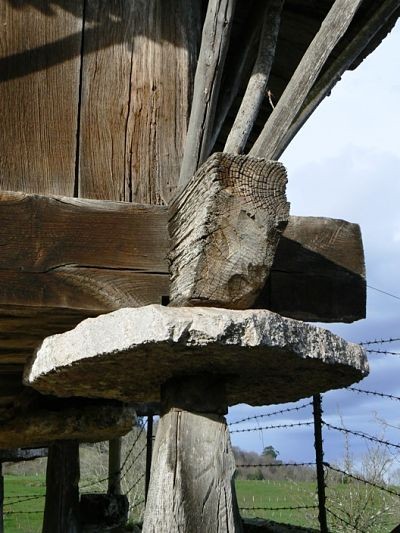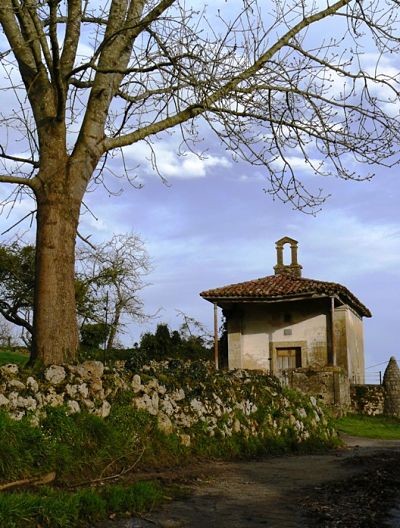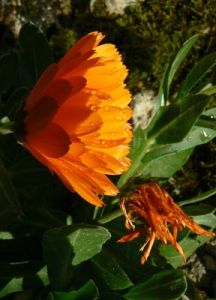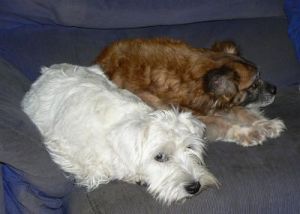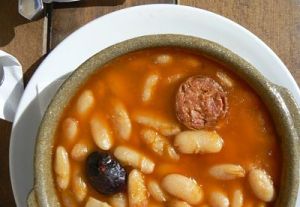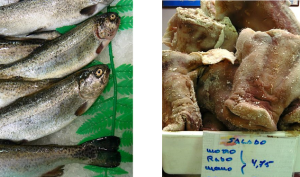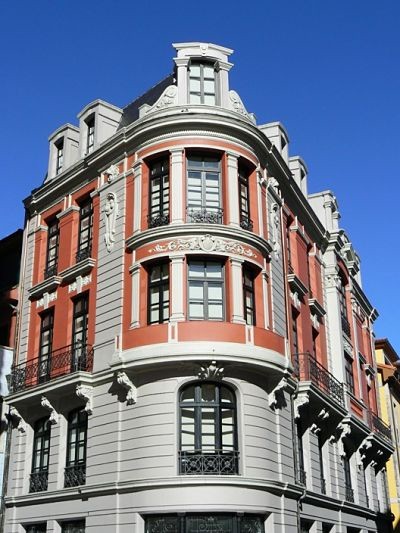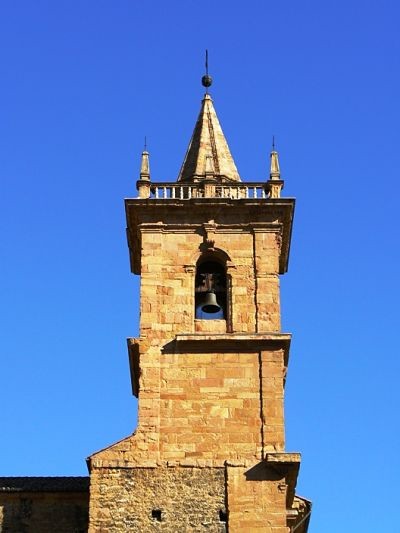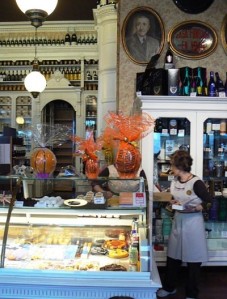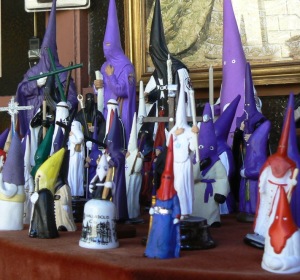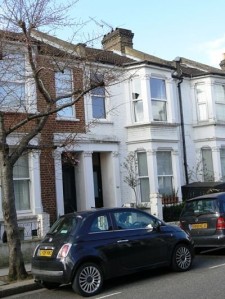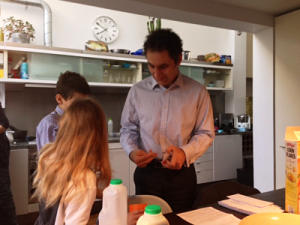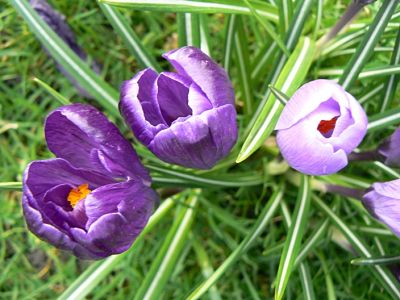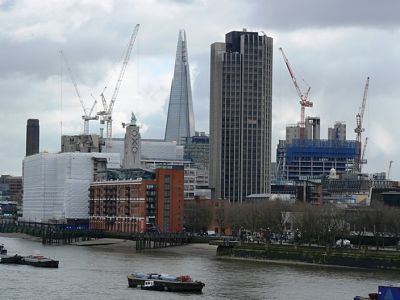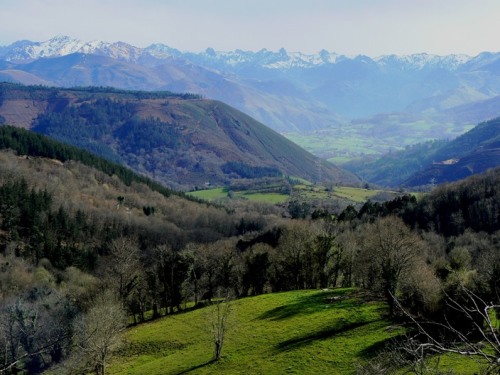
The green side of Spain: verdant valleys in Asturias, and in the background the snow-covered Picos de Europa
I was on the ground for far too long, nearly a month. On Tuesday, March 5, I hopped a slow flight to New York and a very fast one east to Madrid. We were bound for Asturias in northern Spain, to visit an old airline pal, Kyrl Acton, who we met when he was an executive with LAN (in Santiago, Chile), one of American Airlines’ alliance partners. “We” meant my longtime American Airlines colleague Ken Gilbert, who arrived a couple hours after me. Ken retired in October 2012, and we agreed at his farewell reception that we two old travelers ought to do some exploring; a few weeks after that we decided trip one should be to see Kyrl in Asturias.
Before we left, we bought airline passes on Iberia and tickets on the Spanish railway RENFE website. Iberia Airlines’ ground crews were on strike, but it was clear from signboards that some IB flights were operating. We asked at their counter, and learned that there were plenty of seats on the 3:45 departure. Then the confusion started: we visited the airport RENFE ticket office and our request got lost in translation. We asked for a refund, and after a bit of processing we received a credit slip for €96 on a €160 purchase. What? Forty percent fee? We protested. Could he undo the credit, and we’d use the tickets, we asked. He called his boss, and after quite a bit of to and fro the answer was no, sorry, that’s the deal. So we were out $50 apiece, but time to move on, to get north to see Kyrl.
We checked in for the flight and made our way to the Iberia lounge, where, thanks to Ken’s polite persistence, we were allowed in (because we had arrived in business class and were connecting to a domestic flight – Ken knew the usually-bewildering oneworld rules). Spent a pleasant few hours yakking and availing ourselves to the free food and drink. Hopped on the flight and quickly fell into hard sleep. I woke when we started descending, over the tall mountains called Picos de Europa. This was the green part of Spain, really verdant, and to keep it that way, it was pouring when we landed. In no time we were loaded into Kyrl’s Honda and speeding east toward his house. We drove on successively narrower roads until we reached his big house in El Caspio de la Vega, population 16. What’s the English word for a place smaller than a hamlet?
Kyrl had prepped us that Charlie, his Schnauzer puppy, was noisy and skittish. And from the moment we opened the front door he was, in extremis, which created some challenges during our entire visit. This was an Indiano house, meaning it was built by people who made a fortune in the New World (“the Indies”) but returned to Spain to spend it. Kyrl had lived in it since 2005. We unpacked a bit, relaxed and yakked, then headed over the mountain to the seriously local Bar Nava in Lliberdón.
Chalo the owner welcomed us. Kyrl was clearly a regular. We sat down to goggle at the eclectic fittings: taxidermy, old and new photos, and on the shelves behind us insecticides, paint, and several pair of the local wooden clogs, madrañes Asturianas (with three high heels to keep the wearer’s feet clear of muck). Chalo’s sister cooked us some wonderful chicken soup to start, then roast chicken and beef stewed with potatoes. We ate and drank well, and the whole evening cost €35. Before leaving, we ambled into la cocina to thank the cook, elderly, stooped, and grinning. We were feeling good about being in Asturias, a place that has long kept its regional identity (it’s one of the provinces to which Spain grants greater autonomy).
Staying up ‘til midnight on the first night in Europe was a fine idea, because Ken and I slept until nine. Whoa, rising that late hadn’t happened for a long time. Long. After a tonic shower, Kyrl walked me around the grounds of his place, La Finca de Santo Domingo (St. Dominic’s Farm), down to the chapel, where Kyrl helpfully explained that the namesake saint was best known for burning heretics at the stake.
Into the house for a splendid breakfast, then into the car for some touring. We motored back toward Lliberdón, picked up Kyrl’s tweed cap at the bar, then down to the sea for a pleasant short walk on a nice beach east of Colunga. It was the beach where he used to take Smarty, his beloved cocker spaniel, who died eight months earlier; this was his first trip back, and the first with Charlie.
We drove home, dropped some stuff, then headed a few miles west to Toraza and late lunch at the Parilla La Sena. Another great homegrown choice, starting with the local drink of choice, dry cider (sidra), poured from bottle to glass via a long arc, to aerate the drink. Big salads, then a nice local steak, grass-fed and way tender (regular readers know I am not a big beef eater, but appreciate a fine cut of beef raised without a feedlot). For dessert, arroz con leche, a very sweet rice pudding. Skies cleared during lunch, and we enjoyed coffee and a glass of Pacharán (a digestive flavored with sloe or blackthorn, the fruit of a shrub, and served on ice) on the front terrace, with sublime views of the Piloña valley and snowy mountains.
Back at the house, it was time for a nap. The evening was pleasant, a yak with Kyrl and Ken, and a lot of music videos from Kyrl’s vast and catholic collection – we ended with a 1981 Smithsonian production of Alberta Hunter (b. 1895), a jazz singer who returned to performing at age 75, after a 30-year interval as a nurse. She still had all the stuff. We didn’t need dinner, but Kyrl pieced together some great local snacks: some nice cheeses, including the distinctive Gamoneu, dry and hard, with a flavor unlike I’ve ever tasted, crackers, and cured pork loin called lomo iberico bellota.
Was up earlier on Friday morning, 7 o’clock, shaved, showered, out into the yard, with views of the mountains in early sun. Kyrl prepared another cooked breakfast, eggs (well, just one) fried in the goose fat he rendered on Christmas Day, one slice of bacon, toasted Spanish white bread slathered with Tiptree marmalade, and a couple of big mugs of Peruvian coffee. We were set! Rolled down the hill, into Infiesto, the biggest town (pop. 5,000) for miles. Repaired to Barro la Posada, which promised free wi-fi. Except that the elderly owner didn’t know the password, so we had a coffee, waited, and waited some more, until daughter Liliana arrived with her new baby and gave us the key. We were online, wowie, first time in almost two days. Worked my e-mail quickly, then back in the car driving south from Infiesto, up and up into the foothills of the Picos de Europa. Great views in all directions. Back down into Infiesto, fueled the car, then up the hill to pick up Kyrl’s friend Greta.
Greta was an interesting person, way, way interesting. Really she was Gretchen, but Spaniards couldn’t pronounce a name she was given in the Shenandoah Valley of Virginia more than seven decades ago. How a Virginian ended up in a remote valley of Asturias was an interesting story that Kyrl had highlighted the day before. Kyrl described her as “part red Indian” (part Native American), and you could see it in her eyes and cheekbones.
We had a great lunch at, say what, a Japanese restaurant? In Asturias? I admit that when Kyrl declared two nights earlier that we were having Friday lunch at a place that served sushi and such I was sorta unimpressed. But the back story was interesting: a gay couple, one from nearby and one from Nippon. Whoa. The jet plane mixes things up, again. Lunch was terrific, wonderful to get to know Greta (and nice stories about Kyrl when he stepped out for a smoke), and fabulous truly Japanese food. My skepticism abated quickly.
I could relate lots of the conversation, but here’s a single tidbit: Kyrl made some sort of offhanded anti-American remark to which I took strenuous exception by noting that we Americans saved the Irish from Adolf 70 years ago. Point Britton. Kyrl then told us a little story about his father, a Protestant Irish physician who volunteered for the RAF in World War II. The Nazis bombed their RAF base, with lots of casualties, and some asshole officer asked Kyrl’s dad why “he wasn’t tidying up the dead.” Dr. Acton replied that he believed it was more important to attend to the (injured) living, and that obvious remark led to his dispatch to India for an additional two years, punishment for his intemperance. Game, set, match, Acton.
We motored back to the Finca de Santo Domingo, and took a nice walk. As he had done the previous two nights, Kyrl spun an array of vinyl discs, CDs, and music videos. The man has more music and more books than anyone I’ve ever met. Literally, the bookshelves sagged. Friday night, I wondered if Talking to Strangers only applied to true strangers: we got into some long conversation with Greta, and the more we learned more about her, the more interested we became. How did she come to live in Spain for 40 years? We learned about that, and much more. Although the music ranged widely, a lot of it took us back to our youth, or as the Byrds sang (Bob Dylan’s lyrics), “Ah, but I was so much older then / I’m younger than that now.”
Saturday dawned cloudless, with great views of the valleys and mountains. Kyrl once again cooked us a breakfast. At 9:30 we said goodbye to Greta, who promised to look after Charlie and Smoky the cat, and we set off for Oviedo, the provincial capital. Parked at the train station, bought tickets for the 2:26 fast train to Madrid, and set off to have a quick look around. Kyrl continued to be a superb guide, pointing us toward the major sights, including a fine old university building with colonnaded courtyard and the Gothic cathedral. When Ken and I finished walking the church, Kyrl had good news: the café in the cathedral plaza served Fabada Asturiana, a bean and sausage stew that we had not yet sampled. We ordered two and a sampler plate of Asturian cheese for an early lunch. Fortified, we walked a bit more, over to a very old-school food shop, then into Oviedo’s art museum in a nicely renovated old building, which had a remarkably good collection for a city of 225,000, including representative works by Miró, Dali, and Picasso.
Oviedo was a really nice small city, orderly and clean. It was hard to believe that we were in a country with 25% unemployment, because Oviedo was prosperous, with very few beggars or other signs of woe. Kyrl explained that the recession was less severe in Asturias, a good thing.
About 12:30, we said goodbye to our old friend, with effusive thanks. He headed home and we relaxed for a bit, then hopped on the train, which in no time was in the high mountains, and brilliant alpine scenery. The train then descended to the plain, picked up speed, and we reached Madrid just as night fell (Spain has invested substantially in high-speed rail). Hopped the Metro a few stops to the hotel that houses American Airlines crews – a really nice hotel for a good price. Worked a bit on the fast Internet connection, then headed back onto the Metro and down to the Sol neighborhood, well known for its many tapas bars, every one of which was totally packed. But we wedged ourselves into one for a beer and a couple of nice open-faced sandwiches. Ambled on and found another, simple and not very atmospheric, but with room to sit down for another beer and small plates of fried calamari, cod in tomato sauce, and pickled anchovies. Yum.
We were out the door at 8:30 Sunday morning, onto the Metro and out to the airport. I said farewell to Ken and peeled off at the first of the two airport stops. Checked in for my first ride on the low-cost airline EasyJet, ate some breakfast, and continued working a consulting project, revised draft promised later that day. Worked most of the flight, moving my laptop to accommodate the clearly-hungover Brit sitting next to me. We landed in true winter, snow flurries flying on the tarmac at London Luton Airport, north of the city. Hopped on a bus across to Cambridge, and was in guest room H11 at Sidney Sussex College by 3:15. Finished my work, e-mailed the changes, and grabbed a needed nap.
I try to arrange Cambridge teaching at the start of the week, enabling me to attend Evensong in Sidney’s chapel. I was in an oaken pew at 6:15 when the 11 men and 11 women in the celestial college choir processed in. A wonderful service led by the new chaplain, Rev. Paul Brice. After worship we had a quick glass of wine in the old library, and I had a nice chat with parents of a choir member.
We processed to head table in the college dining hall. After the traditional two-word grace in Latin (Benedictus, benedicat, “May the blessed one give a blessing”), we sat down to a great dinner and even better company: across from me was a French woman, wife of a visiting history professor. Next to me was Paul Beecher, a Sidney fellow, electrical engineer and researcher in a nearby Nokia lab, who I had met several times on previous visits. After the meal we continued tradition and repaired to the Knox Shaw Room for port and cheese; I continued to chat with Paul.
Monday it was time to stand and deliver, but first a fascinating breakfast chat with Harvey and Jonathan, the former a fellow in paleontology, and latter a visitor from the Australian university where I taught in 1981 (the University of New England). Both focused on the Cambrian era (~500 million years ago), when animal life began. We yakked about their research. Best tidbit: the biggest animal of the era was three feet long with well developed front claws and stalked eyes. “Scary,” Harvey said simply. Conversations like that are one of the additional rewards of my teaching trips.
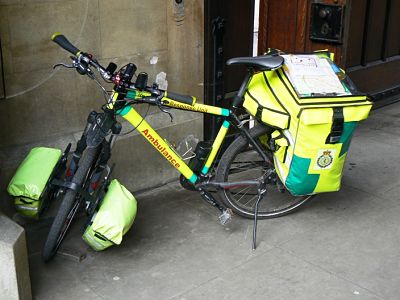
I’m sure U.S. critics of single-payer U.K. health care would deride this ambulance, but I thought it was an innovation when patient transport was not needed!
At 10:15, I met Christine Menges, a lecturer at Cambridge’s other university, Anglia Ruskin. She’s the wife of Jochen, a young Cambridge prof who I first met in 2008 in St. Gallen, Switzerland, where he was finishing his Ph.D. Christine explained that this was less a school of privilege, more likely to attract people from disadvantaged backgrounds or who had struggled early in life. The facilities were modern. From 11 to noon I delivered a talk on leadership, way too brief but very well received (including a rare whoop of approval!). We met Jochen for a big Italian lunch, and I headed to his HR class in a very old building on the University of Cambridge campus; it was one-third Masters students and two-thirds undergrads. It was lively, and we had plenty of time.
Peeled off after four, back to college to work. At 6:30 I met Paul Tracey, a Judge professor and colleague of my friend Jan Heide at the University of Wisconsin. I first met Paul, a Scot, about 15 months earlier – I haven’t actually spoken to one of his classes, but that’s likely to change within a year, when he returns from research leave. We got caught up on his research and life over a pint at The Pickerel, a great pub right on the river, then a light dinner at a tapas place.
Up at 6:15, out the door, train to London, then the Tube to my Airbnb digs in North Kensington. The Aussie Airbnb hosts from the two most recent London visits were already full, but as soon as my new host Sallyjo opened the door I knew I had found another great place. As I wrote late last year, Airbnb is more than a bed cheaper than a hotel, it’s an opportunity to interact with locals. I immediately felt at home, and within 20 minutes felt I knew Sallyjo and her husband Savas, who was just leaving for work. I wanted to sit down for a cup of tea, but needed to scoot.
From 11:30 to 12:45 I delivered my now-annual talk to the Marketing Club at London Business School, and spent another 40 minutes yakking in the hall with interested students. At 1:30 I met Rajesh Chandy, a prof I’ve known for several years, for lunch and a good yak. Keep moving! At 4:30 I met Geoffrey Owen, my host at London School of Economics, and from 5 to 6:20 I listened to and helped evaluate a student team presentation. Sir Geoffrey, his colleague David DeMeza, and another David (head of the LSE finance faculty) met at Cooper’s for a drink and dinner. That was a busy day.
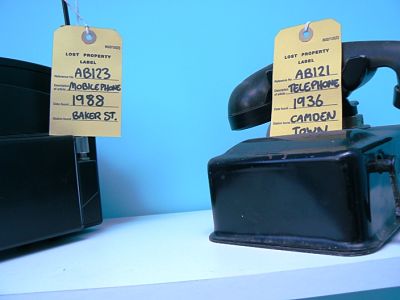
Walking south from London Business School, the window display of London Transport’s Lost Property Office caught my eye; they were still looking for the passenger who in 1936 left this telephone on the Tube at Camden Town!
It was great fun to be up early on Wednesday the 13th and down to the kitchen to visit with Sallyjo’s and Sav’s children, Luca, 11, and Mimi, 9. Mom and dad were raising them right – they were polite, engaging, and bright. After being away for a week, feeling like I was a little part of the family brought great joy. The kids left for school, I yakked a bit with Sallyjo and Sav, then headed across town for a cup of coffee and catch-up with my young entrepreneur friend Jonathan, whose company was almost ready for launch, a very exciting prospect.
Next stop was lunch at The Wolseley, a new but old-school dining room on Piccadilly; in the 1920s it was the showroom for the automobile of the same name. It was time for the annual caloric and laugh-filled repast with David Holmes, my old pal from British Airways. Sensational plate of haddock, a glass of merlot, and banter with a very bright fellow grandfather, classics scholar, and splendid observer of the wide panorama of the U.K. since the 1940s. The man can discuss the finer points of European Union regional development one minute (turns out that in Britain they don’t put up a plaque in a railway station or similar piece of infrastructure noting that the EU funded the improvements); and the next apply the wisdom of Winnie the Pooh and Piglet to Prime Minister Cameron’s balancing act with Europe. One must keep on one’s toes when dining with David. It’s a high point of every March visit.
I headed home, worked for a couple of hours, then set off on foot, south toward Notting Hill via Portobello Road, site of the famous market. At 6:30, I met my young friend Scott Sage (frequently mentioned in these pages) and, for the first time, his fiancée Caroline. We had a good chat and a wonderful meal at an upscale Indian restaurant, Chakra. Their flat was on my route home, so we yakked and walked, said goodbye with hugs, and I ambled on. A lot of walking that day, and I was asleep by 9:45.
Up at 6:10, out the door quietly (the family was still sleeping, so I said my farewells and thanks the night before), south to the Tube, out to Heathrow, west to New York, then south to Washington.
!["Powerless Structures, Fig. 101," a new bronze in Trafalgar Square; on the plaque beneath it, artists Elmgreen and Dragset wrote, "A child has been elevated to the status of historical hero, though there is not yet a history to commemorate -- only a future to hope for . . . we wanted to create a public sculpture which, rather than dealing with topics of victory or defeat [like the other monuments in the square], honours the everyday battles of growing up." Amen to that!](https://robbrittonthetraveler.files.wordpress.com/2013/03/hobbyhorse_opt-e1363550526506.jpg?w=500)
“Powerless Structures, Fig. 101,” a new bronze in Trafalgar Square; on the plaque beneath it, artists Elmgreen and Dragset wrote, “A child has been elevated to the status of historical hero, though there is not yet a history to commemorate — only a future to hope for . . . we wanted to create a public sculpture which, rather than dealing with topics of victory or defeat [like the other monuments in the square], honours the everyday battles of growing up.” The statue sits on the fourth plinth in the square; 170 years ago a sculptor prepared an equestrian statue of Charles IV, but it was never installed. I think the new one works much better!

